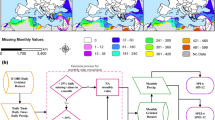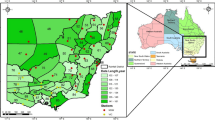Abstract
Uncertain future climate, recent persistent droughts, and subsequent water conflicts increasingly threaten the sustainability of regional water resources in the United States. Climate change and ongoing water disputes brought about by changes in water availability and timing emphasize the need for decision makers to develop proactive adaptive management strategies to mitigate losses. Developing a drought management system equipped with advanced visualization settings is critical to lay out drought evolvement at local scales, yet an effort has not been made to evaluate how different spatial discretization can represent local drought as opposed to conventional drought monitoring. Gridded drought indices, including the standardized precipitation index (SPI), Palmer drought severity index (PDSI), and Hydrologic drought index (HDI) at high-resolution spatial (12 km by 12 km) scales are demonstrated to provide useful insights to evaluate local drought possibly driven by a rapidly changing global environment. A new method for duration factors in PDSI is also discussed to better represent drought conditions over time and space.






Similar content being viewed by others
References
Dai A (2011) Characteristics and trends in various forms of the Palmer Drought Severity Index during 1900–2008. J Geophys Res 116, D12115
Daly C, Taylor G (2001) PRISM precipitation maps. Oregon State University, Spatial Climate Analysis Service and State of Oregon Climate Service (available at http://www.prism.oregonstate.edu/, accessed October 13, 2010)
Daly C, Neilson RP, Phillips DL (1994) A statistical-topographic model for mapping climatological precipitation over mountanious terrain. J Appl Meteorol 33(2):140–158
Guttman NB (1998) Comparing the Palmer drought index and the Standard Precipitation Index. J Am Water Resour Assoc 34(1):113–121
Kansa Water Office (2009) Upper Republican River Basin. Kansas Water Office, January 2009 Kansas Water Plan Report
Koster RD, Guo Z, Yang R, Dirmeyer PA, Mitchell K, Puma MJ (2009) On the nature of soil moisture in land surface models. J Clim 22
Liang X, Letternmaier DP, Wood EF, Burges SJ (1994) A simple hydrologically based model of land surface water and energy fluxes for general circulation models. J Geophys Res 99:14415–14428
Lott N, Smith A, Houston T, Shein K, Crouch J (2013) Billion-Dollar U.S. weather/climate disasters 1980–2012. National Climatic Data Center, Asheville, Accessed April 2, 2013
Luo L, Wood EF (2007) Monitoring and predicting the 2007 U.S. drought. Geophys Res Lett 34, L22702
Maurer EP, Wood AW, Adam J, Letternmaier DP, Nijssen B (2002) A long-term hydrologically-based data set of land surface fluxes and states for the conteminous United States. J Clim 15(22):3237–3251
Mavromatis T (2007) Drought index evaluation for assessing future wheat production in Greece. Int J Climatol 27:911–924
McKee TB, Doesken NJ, Kleist J (1993) The relationship of drought frequency and duration to time scales. 8th Conference on Applied Climatology, 17–22 January, 179–184
Nalbantis I (2008) Evaluation of a hydrological drought index. Eur Water 23–24:67–77
Nalbantis I, Tsakiris G (2009) Assessment of hydrological drought revisited. Water Resour Manag 23:881–897
NIDIS (2007) The national integrated drought information system implementation plan. National Integrated Drought Information System, Available on-line http://www.drought.gov
Palmer WC (1965) Meteorological drought. Research paper no. 45, Weather Bureau, US Department of Commerce, Washington DC, 58
Ryu JH, Svoboda MD, Lenters JD, Tadesse T, Knutson CL (2010) Potential extents for ENSO-driven hydrologic drought forecasts in the United States. Clim Chang 101:575–597
Shepard DS (1984) Computer mapping: the SYMAP interpolation algorithm. In: Gaile GL, Wilmott CJ, Reidel D (eds) Spatial satistics and models, 133–145
Shukla S, Wood AW (2008) Use of a standardized runoff index for characterizing hydrologic drought. Geophys Res Lett 35, L02405
Tabari H, Nikbakht J, Talaee PH (2013) Hydrological drought assessment in Northwestern Iran based on streamflow drought index (SDI). Water Resour Manag 27(1):137–151
Thornthwaite CW (1948) An approach toward a rational classification of climate. Geogr Rev 38(1):55–94
Tsakiris G, Pangalou D, Vangelis H (2007) Regional drought assessment based on the Reconnaissance Drought Index (RDI). Water Resour Manag 21(5):821–833
Vicente-Serrano SM, Begueria S, Lopez-Moreno JI (2010a) A multiscalar drought index sensitive to global warming: the standardized precipitation evapotranspiration index. J Clim 23:1696–1718
Vicente-Serrano SM, Begueria S, Lopez-Moreno JI, Angulo M, Kenawy AE (2010b) A new global 0.5^0 gridded dataset (1901–2006) of a multiscalar drought index: comparison with current drought index datasets based on the palmer drought severity index. J Hydrometeorol 11(4):1033–1043
Wells N, Goddard S, Hayes MJ (2004) A self-calibrating palmer drought severity index. J Clim 17:2335–2351
Widmann M, Bretherton CS (2000) Validation of mesoscale precipitation in the NCEP reanalysis using a new gridcell dataset for the northwestern United States. J Clim 13:1936–1950
Acknowledgments
This research was mainly funded by the NSF Idaho EPSCoR Program and by the National Science Foundation under award number EPS-0814387. Partial funding support for Jae Ryu is also made from NASA under award No NNX08AL94G. Its contents are solely the responsibility of the authors and do not necessarily represent the official views of NSF and NASA.
Author information
Authors and Affiliations
Corresponding author
Rights and permissions
About this article
Cite this article
Ryu, J.H., Sohrabi, M. & Acharya, A. Toward Mapping Gridded Drought Indices to Evaluate Local Drought in a Rapidly Changing Global Environment. Water Resour Manage 28, 3859–3869 (2014). https://doi.org/10.1007/s11269-014-0714-z
Received:
Accepted:
Published:
Issue Date:
DOI: https://doi.org/10.1007/s11269-014-0714-z




